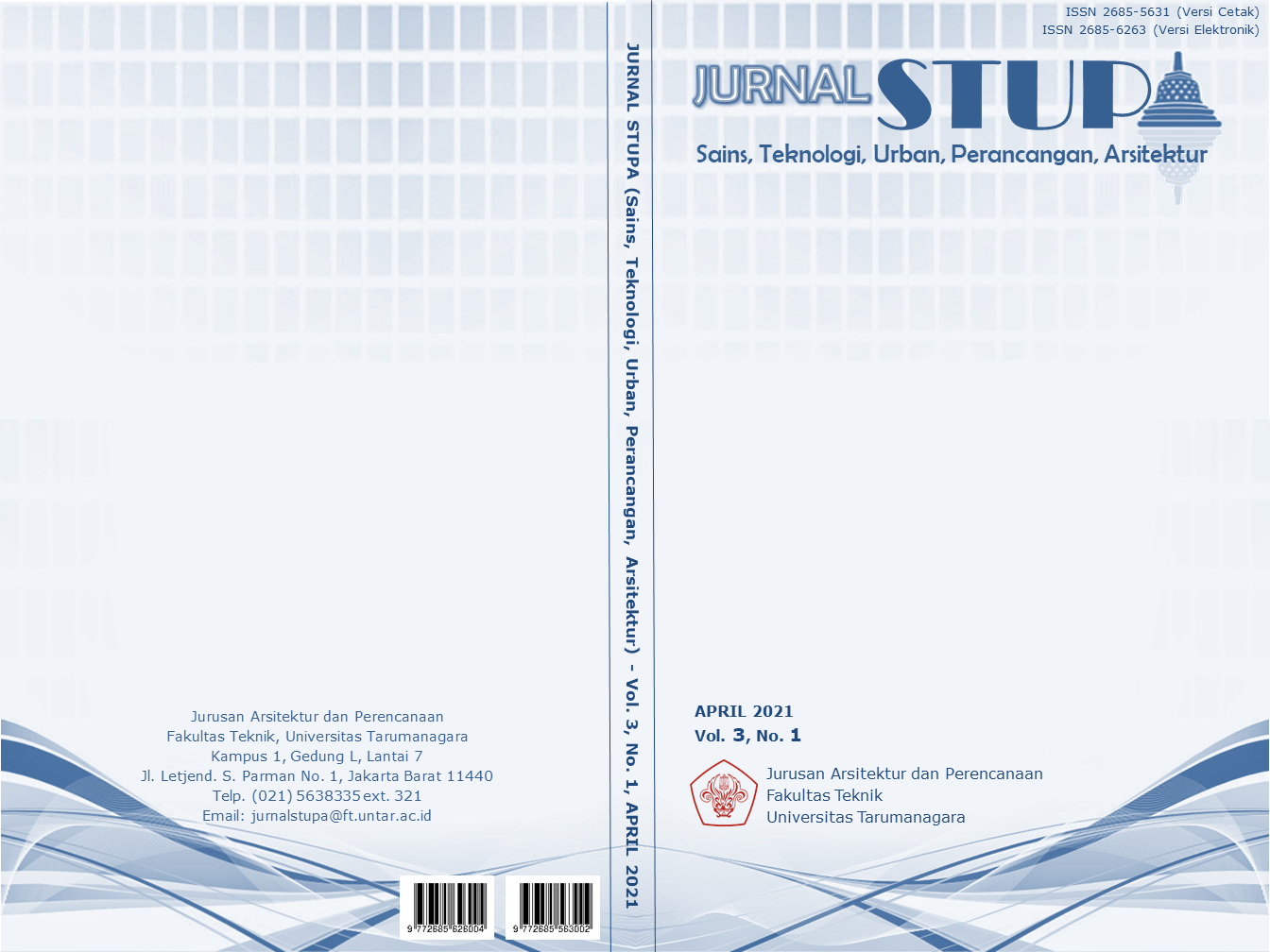SEKOLAH DASAR ABAD-21 DENGAN METODE BAHASA POLA DAN METAFORA DALAM PENCIPTAAN RUANG BELAJAR KREATIF DI KELAPA GADING
Main Article Content
Abstract
The advancement of technology in the world is marked by the industrial revolution event. Indonesia has entered the era of the industrial revolution 4.0. This incident affects the way society dwell, slowly our lives have been dominated by technology and it is possible that in the future humans will be replaced by robots. We must developing soft skills that cannot be replaced by robots through our education. Indonesia’s education itself does not prepare the next generation to deal with this event. Starting from outdated curriculum, teachers who are afraid to explore in teaching to school buildings that still adhere to the school system in the 19th century. The study of the discussion is how human dwell in the future in this case is to study, namely primary school buildings, which can accommodate teaching and learning activities with a curriculum that suits future needs. The design method used is in form of design stages, starting from Area Analysis; Investigation of selected sites; Proposed Program; Design Analysis: Composition of mass and the concept of mass of buildings using the Metaphor Method; Project Zoning; Application of Pattern Language Methods and Structure and Building Materials. The result of this research is an elementary school architectural building that accmodate 21st century learning.
Keywords: creativity; education; metaphorical architecture; pattern langugae;primary school
Abstrak
Kemajuan teknologi didunia ditandai dengan adanya peristiwa revolusi industri. Indonesia telah memasuki era revolusi industri 4.0. Peristiwa ini memengaruhi cara masyarakat berhuni, secara perlahan kehidupan kita telah didominasi dengan teknologi dan tidak menutup kemungkinan dimasa depan manusia akan digantikan dengan robot. Lalu, bagaimana kita sebagai manusia menghadapi ini ? yaitu mengembangkan softskill yang tidak bisa digantikan oleh robot melalui pendidikan kita. Pendidikan Indonesia tidak menyiapkan generasi selanjutnya untuk menghadapi perisitiwa ini. Berawal dari kurikulum yang sudah usang, lalu para guru yang takut untuk bereksplorasi dalam mengajar hingga bangunan sekolah yang masih menganut sistem sekolah di abad-19. Lingkup pembahasan laporan ini adalah bagaimana wadah berhuni manusia dimasa depan yaitu kegiatan menuntut ilmu, yaitu bangunan sekolah dasar, yang dapat mewadahi kegiatan pembelajaran dengan kurikulum masa depan. Metode perancangan yang digunakan adalah; a) Analisis Kawasan; b) Investigasi tapak terpilih; c) Usulan program; d) Analisis Perancangan : Gubahan massa dan Konsep Massa bangunan dengan Metode Arsitektur Metafora; d) Penzoningan Pada Proyek; e) Penerapan Metode Bahasa Pola dan f) Struktur dan Material Bangunan. Hasil akhir dari penelitian ini berupa bangunan arsitektur sekolah dasar yang mewadahi kegiatan pembelajaran abad-21.
Article Details
References
Antoniades, A. C. (1992). Poetics of Architecture: Theory of Design. New York: Van Nostrand Reinhold.
Dudek, M. (2005). Children's Spaces. New York: Routledge.
Hapsah, A. (Director). (2018). Indonesia Ketinggalan 128 Tahun [Motion Picture].
Heidegger, M. (1971). Building, Dwelling Thinking. New York: Harper Colophon Books.
Heidegger, M. (2010). Being and Time . New York: State University of New York Press.
Jencks, C. (1977). The Language of Postmodern Architecture. New York: Rizolli.
Nair, P. (2014). Blueprint for Tomorrow : Redesigning Schools for Student-Centered Learning. Cambridge: Harvard Education Publishing Group.
Puckett, K. (2017, July n.d.). https://www.the-possible.com/future-of-education-digital-campus-learning-teaching/. Retrieved from https://www.the-possible.com/.
Rosenfield, K. (2013, January 3). https://www.archdaily.com/313736/study-proves-design-significantly-impacts-learning. Retrieved from https://www.archdaily.com/.
Schulz, C. N. (1958). The Concept of Dwelling : On The Way to Figurative Architecture. New York: Rizolli International Publications.
Synder, J. C., & Catanese, A. J. (1979). Introduction of Architecture. New York: McGraw-Hill.
Thoring, K. (2019). Designing Creative Space. A Systemic View on Workspace Design and It's Impact on the Creative Process, 84-99, 130-140.
Trisno, R., & Lianto, F. (2019). Relationship between function-form in the expression of archictecture creation. Advance Preprint.
Yunus, S. (2019, April 27). https://www.indonesiana.id/read/119880/empat-sebab-rendahnya-kompetensi-guru. Retrieved from https://www.indonesiana.id/: https://www.indonesiana.id/read/119880/empat-sebab-rendahnya-kompetensi-guru.



